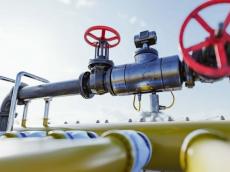Today.Az » Analytics » Azerbaijan enhances gas exports, strengthening energy trade relations with Europe
10 September 2024 [16:53] - Today.Az

A successful strategy is being implemented in Azerbaijan's energy sector, which is a crucial part of the country’s economy due to its rich natural resources. Azerbaijan, one of the oldest oil-producing regions in the world, is currently home to some of the most significant oil and gas reserves. The country has historically served as a bridge between Europe and Asia. Azerbaijan’s strategic location and resource wealth enable it to export oil and gas to European markets. The country transports gas to Europe through the Southern Gas Corridor, which includes the Trans-Adriatic Pipeline (TAP). TAP has a transmission capacity of 12 billion cubic meters per year. From January to August of this year, Azerbaijan exported 8.4 billion cubic meters of natural gas to Europe. This represents an increase of 0.8 billion cubic meters, or 10.5%, compared to the same period in 2023. Overall, Azerbaijan’s gas exports for the year totaled 16.4 billion cubic meters, marking a 3.1% increase from the previous year. In July 2022, Azerbaijan and the European Commission signed an energy memorandum in Baku, agreeing to double the volume of transported gas. This agreement was made five months after the start of the Russian-Ukrainian war. Since then, the European Union has shown increased interest in expanding the Southern Gas Corridor, with expectations for tangible decisions in this area. Additionally, Ukrainian President Volodymyr Zelensky announced that Ukraine would not extend its contract with Gazprom for the transit of Russian gas. However, Ukraine will continue to transit gas from other Russian exporters. After Europe weathered the winter of 2022-2023, it revised its plans to expand the Southern Gas Corridor due to a sufficient supply of gas reserves. With the successful replacement of Russian gas, the European Union's focus has shifted back to its policy of reducing reliance on fossil fuels, including oil and gas. As part of this policy, European financial institutions are increasingly refraining from funding oil and gas projects. Despite this, Azerbaijan intends to increase its gas exports to the European market. In 2021, Azerbaijan exported about 10 billion cubic meters of gas to the European Union. This figure is projected to rise to 10.4 billion cubic meters in 2022, 12 billion cubic meters in 2023, and is expected to reach 13 billion cubic meters in 2024. In the first eight months of this year, Azerbaijan exported 6.5 billion cubic meters of gas to Turkiye and 1.5 billion cubic meters to Georgia. Gas exports to Turkiye decreased by 0.2 billion cubic meters, or 3%, while exports to Georgia remained unchanged compared to the same period last year. During this period, approximately 3.7 billion cubic meters of gas were transported to Turkiye via the Trans-Anatolian Gas Pipeline (TANAP), marking a 0.1 billion cubic meters, or 2.6%, decrease from the previous year. The Trans-Adriatic Pipeline (TAP), part of the Southern Gas Corridor, was completed in October 2020. This pipeline stretches 878 kilometers, including 550 kilometers through northern Greece, 215 kilometers through Albania, 105 kilometers under the Adriatic Sea, and 8 kilometers through Italy. Gas supplies through TAP began on December 31, 2020, delivering Azerbaijani gas to Italy, Greece, and Bulgaria. Azerbaijan’s gas production has increased by 2.5% this year, reaching approximately 33 billion cubic meters. Production figures include 8.7 billion cubic meters from the Azeri-Chirag-Gunashli (ACG) fields, 18.1 billion cubic meters from Shah Deniz, 1.1 billion cubic meters from Absheron, and 5.1 billion cubic meters from SOCAR. This represents an increase of about 0.8 billion cubic meters compared to the same period last year. Since the commissioning of the ACG and Shah Deniz fields, 643 million tons of oil (including condensate) and 452.2 billion cubic meters of gas have been produced up to September 1. Specifically, ACG has produced 595.8 million tons of oil and 225 billion cubic meters of gas, while Shah Deniz has produced 227.2 billion cubic meters of gas and 47.2 million tons of condensate. Total exports from these fields amount to approximately 641.2 million tons of oil (including condensate) and about 162 billion cubic meters of gas. The confirmed reserves of the Shah Deniz field are estimated at approximately 1.2 trillion cubic meters. Additionally, the discovery of the Umid and Babek fields enhances Azerbaijan’s gas potential. Currently, an average of 3.1 million cubic meters of gas and 470 tons of condensate are produced daily from four operational wells in the Umid field. Since production began in 2012, approximately 6.7 billion cubic meters of gas and 1 million tons of condensate have been extracted. Plans are in place to drill and commission two additional wells from the Umid-1 platform. These new gas fields enable Azerbaijan to expand its gas exports further while utilizing renewable energy resources. Azerbaijan continues to strengthen its position as a key player in the global energy market through strategic utilization of its vast oil and gas reserves. Despite Europe's shift away from fossil fuels and a reduction in plans to expand the Southern Gas Corridor, Azerbaijan is increasing its gas exports to Europe and maintaining its role as a crucial energy supplier. The country's production has risen, and new discoveries, such as the Umid and Babek fields, further enhance its export capabilities. Azerbaijan’s strategic infrastructure, including TAP and TANAP, and its commitment to expanding its energy output, underscore its pivotal role in regional and global energy dynamics.
|